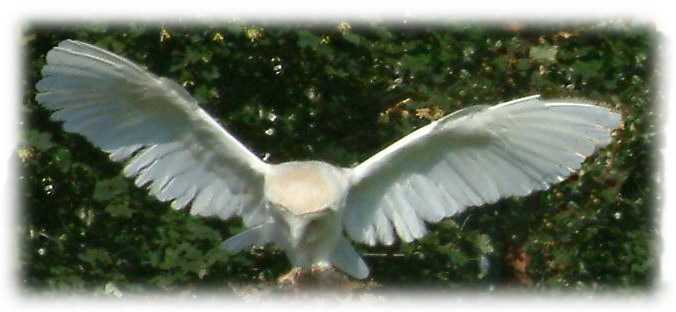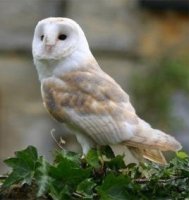|
|
Barn Owl Facts

- Other old names for the Barn Owl are, Grass Owl, White Owl,
Ghost Owl, Screech Owl.
- Scientific Name,The scientific name, is 'Tyto Alba', in
Greek 'Tyto' means Owl and in Latin 'Albe' means
White 'Owl White' there is also another race called Tyto
Guttata from central, East and North West Europe, which is a strong
buff colour below and grey blue wings.
- A 'Parliament' is the name for a group of owls.
- An 'Owlet' is the name for a young owl.
- A 'Pulli' is a baby owl.
- The Barn Owl has Long Legs to help catch prey.
- It is completely silent in flight due to it soft outer
feathers, because of these feathers the Barn owl is not water
proof, most bird are waterproofed to some degree, and therefore
will not hunt in the rain unless desperate.
- Length : 300mm (12") approximately.
- Wingspan : 850mm (33.5") to 930mm (36.5")
approximately.
- Weight : 240 grams (8 oz) to 360 grams (13 oz).
- Types of Rings, Wild Barn Owls are fitted with split rings
(usually size 'U'). Captive Barn Owls are ringed with a
closed ring which is fitted when the chick is between 10 and 21
days old.
- Owl Pellets, black about the size of a mans thumb.
- Books, Everything you want to know about OWLS, isbn 1
900732 05
X, Understanding Owls, Jemima Parry-Jones, isbn 0 7153 1223-5.
- Eggs and Staggered Hatching, Depending on how many voles /
mice
are about will depend on the number of eggs layed but is usually
about 5, the eggs usually hatch after about 30 days, there is also
2 days between each egg, this is so that if the food
supply becomes
short the youngest owl will die, giving the other young a chance to
survive.
- Fledgling, Barn Owl can take up to 8 weeks to
fledge, once
fledged the parents will continue to feed the young for about
another 4 weeks.
- Hearing, The ears are at each side and are covered by
feathers,
one ear is set higher than the other it is believed that this helps
them to locate prey.
- Neck and Eyes, there eyes are so large that they cannot
swivel
them in there sockets, to compensate for this there neck can turn
through 270 degrees.

- Food, mainly, voles, mice, shrews sometimes small birds and
bats.
- Prey, The Barn Owl will usually try to swallow its prey
whole,
if it is to large it will rip it into pieces, a number of hours
later it will cough up a pellet which is about the size of a mans
thumb, black to dark grey in colour, and consist of the animals
bones and fur.
- Sound, Snores, Hisses and Barks.
- Nests. In the old days the barn owl would nest in farmers
barns
with an opening in the brick / wood work for the the owl the enter
the loft space and leave for hunting, the farmers would keep
grain
in the barn ideal habitat for mice and rats, just what the Bran Owl
is looking for.
- Protection, The Barn Owl and its Breeding Sites are
protected
by the Wildlife and Countryside Act 1981. and is protected as
a Schedule 1 bird.
- The Barn Owl belongs to the Raptor group of birds, because
there feet have sharp talons and there beaks are used for ripping
and taring animals, this group also includes Hawks, Eagles
and
Falcons.

|



